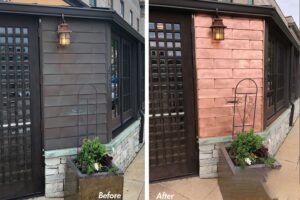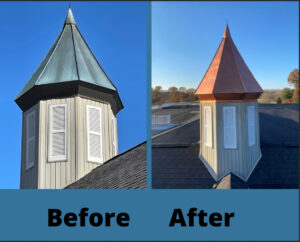
Few architectural materials have stood the test of time quite like copper.
From ancient Egypt to contemporary buildings of today, it has remained a construction mainstay for thousands of years. Common applications include wall cladding, roofing, flashing and gutters.
One of the most beloved features of copper is the self-generated patina that develops over time. This phenomenon adds a distinctive character and aesthetic value to a building’s exterior . Other advantages behind copper’s enduring popularity include its strength, malleability, recycleability and corrosion resistance.
Like all construction materials, copper is vulnerable to various forms of damage and has unique maintenance needs. Whether your goal is to maintain its original shiny appearance or speed up the patination process, Mid America Specialty Services offers the specialized finishing techniques required to achieve your goals.
Sources of Damage to Copper
Copper’s malleability makes it an ideal material for those wanting customized architectural designs. However, that same characteristic makes it vulnerable to scratches, dents and other damage from improper maintenance techniques or impact from heavy objects, hail or vandalism. Punctures may weaken the material and create an inconsistent appearance as patination progresses.
Like all exterior building materials, copper accumulates dirt and debris which degrade its appearance over time. Damage may include unsightly smudges from hands and paws, as well as accumulated tar, soot, oil and bird droppings.
Chemical Patination
That familiar patina we see on copper structures is caused by surface oxidation. This results in a copper oxide layer which gradually thickens. Because oxidation is not a uniform process in its earliest stages, the surface color may appear somewhat uneven until the patina matures.
Natural patination typically takes about 25 years. However, various factors may shorten or lengthen this process. For buildings located in warm, humid regions, patination occurs more quickly and typically yields a blue-green color. In arid regions, patination takes longer and may result in a deep brownish color instead of green. Exposure to acids, oil, cleaning solutions and dirt may also influence patina formation.
For building managers who would like to achieve a patinated appearance more quickly, there are treatments available to achieve this goal. MASS technicians use advanced products and refinishing techniques to create an authentic-looking patina instantaneously. Considerations in choosing patination products include surface characteristics, application technique requirements and ambient temperatures.
Sometimes individual copper panels may need replacing due punctures, dents or other damage. This may result in an uneven appearance between old and new panels. To address this issue, patination treatments can be applied so that the new panels more closely resemble the old ones.
Finally, for those wanting to preserve a bright shiny finish like a new penny, a clear sealer is applied to the copper to prevent oxidation.
Restoration & Maintenance of Copper
With proper care and maintenance, copper assets can remain in place for as long as 80 years and beyond.
Periodic inspections are recommended to check for loose or damaged components. The surface should be kept clear of standing water, and debris should be promptly removed. Minor dents or scratches may fade on their own as the oxidation process causes them to blend in with the rest of the surface. More conspicuous damage may require professional refinishing or repair services.
Although copper is highly resistant to algae and mold, it may be vulnerable to hand prints, oils, dirt and debris. In most cases these contaminants can be removed by gently rinsing with clean water. If a cleaning product and power washing are required, a low-pressure setting is recommended
At Mid America Specialty Services, our professional refinishers have the expertise to restore architectural copper and keep it looking beautiful for years to come.
You can reach us at 800-544-4576 or contact us online.
